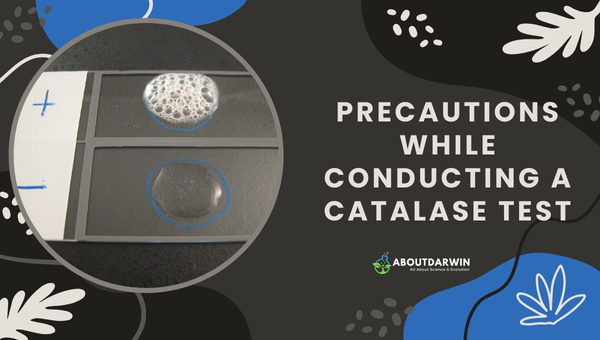Physical Address
304 North Cardinal St.
Dorchester Center, MA 02124
The catalase test is a fundamental procedure in microbiology that identifies the presence of the catalase enzyme in various organisms. This enzyme is crucial for breaking down hydrogen peroxide into water and oxygen, thereby protecting cells from oxidative damage.
In clinical settings, the catalase test aids in diagnosing conditions like chronic granulomatous disease and differentiating bacterial species, such as Staphylococci and Streptococci.
As you explore this essential test, you’ll discover its significant implications for both health diagnostics and microbiological research, revealing a fascinating intersection of biology and medicine.
Contents
The catalase test is an essential technique in microbiology, widely used to assess the presence of the enzyme catalase in bacterial cells. Catalase is crucial for defending cells against oxidative damage by decomposing hydrogen peroxide (H₂O₂) into harmless water and oxygen.
In catalase testing, a small sample of the microorganism is exposed to hydrogen peroxide. The observation of bubbles or effervescence indicates a positive reaction, confirming the presence of catalase.
Analyzing catalase test results helps distinguish between catalase-positive and catalase-negative bacteria, providing valuable insights for the identification of bacterial species in microbiological studies.
Catalase test microbiology plays a significant role in diagnosing infections and understanding microbial behavior in various environments.
The catalase test serves several important purposes in microbiology, primarily focusing on the identification and differentiation of bacterial species based on their ability to produce the enzyme catalase.
This enzyme plays a critical role in protecting bacteria from oxidative damage caused by hydrogen peroxide, a byproduct of aerobic metabolism. The test is essential for distinguishing between various genera and species of bacteria, particularly those that are morphologically similar.
Below are the key purposes of the catalase test:
Overall, the catalase test is a straightforward yet powerful tool that enhances our of bacterial physiology and aids in effective clinical diagnosis.
The catalase test is a vital microbiological procedure used to identify and differentiate bacterial species based on their ability to produce the enzyme catalase.
This enzyme breaks down hydrogen peroxide (H₂O₂) into water and oxygen, providing protection against oxidative stress. The catalase positive meaning and catalase negative meaning is crucial for interpreting the results of this test.
Below are the detailed catalase test procedure and catalase test steps involved in conducting this essential test.
Materials Needed:
Multiple factors might affect the precise outcomes during a catalase test. These influencing components can cause irregularities in expected results:
In general, ensuring correct sampling methods and maintaining quality control in test environments are vital for accurate interpretations during catalase tests. It is always important to discuss any unexpected or ambiguous results with a qualified healthcare provider
This simple yet effective test is essential in microbiology for identifying bacterial isolates based on their enzymatic properties.
The primary reason for performing the catalase test with hydrogen peroxide is to detect the presence of the catalase enzyme in bacterial cultures.
When hydrogen peroxide is added to a sample containing catalase, it decomposes into water and oxygen, resulting in the formation of bubbles.
This effervescence indicates a positive test result, confirming that the organism can produce catalase, which is vital for its survival in oxygen-rich environments.
2H2O2 ⟶ 2H2O + O2
Catalase is an essential enzyme found in various bacteria, playing a crucial role in protecting these microorganisms from oxidative damage caused by hydrogen peroxide (H₂O₂). This enzyme catalyzes the decomposition of hydrogen peroxide into harmless water and oxygen, thus preventing cellular damage.
The presence of catalase not only aids in the survival of bacteria under aerobic conditions but also serves as a vital tool for identifying and classifying bacterial species.
Protection Against Oxidative Stress:
Role in Metabolism and Growth:
Identification and Classification of Bacteria:
Diversity Among Bacterial Species:
The importance of catalase in bacteria provides insights into their metabolic processes and adaptations to environmental stresses.
The catalase test is a crucial diagnostic tool in microbiology, used to detect the presence of the enzyme catalase in bacterial isolates. This enzyme plays a vital role in protecting bacteria from oxidative damage caused by hydrogen peroxide, a byproduct of aerobic metabolism.

The test differentiates between catalase-positive bacteria, such as Staphylococcus, and catalase-negative bacteria, such as Streptococcus. The principle behind the catalase test is essential for accurate bacterial identification and classification.
| Aspect | Details |
|---|---|
| Test Name | Catalase Test |
| Purpose | To detect the presence of the enzyme catalase in bacterial isolates. |
| Significance | Differentiates between catalase-positive and catalase-negative bacteria. |
| Catalase Reaction | The enzyme catalase decomposes hydrogen peroxide (H₂O₂) into water (H₂O) and oxygen (O₂). |
| Positive Result | Rapid formation of bubbles indicates the presence of catalase. |
| Negative Result | Lack of bubbles indicates absence of catalase. |
| Examples of Catalase-Positive Bacteria | Staphylococcus species |
| Examples of Catalase-Negative Bacteria | Streptococcus species |
| Importance of Catalase | Protects aerobic and facultative anaerobic bacteria from oxidative damage caused by H₂O₂. |
Also Read: Planning a Perfect Family Reunion: A Comprehensive Guide
The catalase test is a crucial diagnostic tool in various scientific and medical fields, particularly in microbiology and clinical diagnostics.
It provides vital information regarding the presence and activity of catalase enzymes in organisms, serving two primary purposes: medical diagnosis and bacterial identification.
Catalase enzymes are naturally produced by the human body to help regulate reactive oxygen species, such as hydrogen peroxide. These enzymes are essential for protecting cells from oxidative damage.
Abnormal levels of catalase can indicate various health conditions:
By providing rapid insights into enzyme activity, catalase tests can help clinicians identify potential medical issues that might otherwise go unnoticed.
In microbiological laboratories, the catalase test is routinely employed to differentiate bacterial species based on their ability to produce catalase:
The distinct reactions observed during the catalase test assist in classifying and identifying various bacterial samples effectively.
The catalase test plays a pivotal role in both medical diagnostics and microbiological research. By elucidating the presence and functionality of catalase enzymes, it aids in diagnosing hereditary conditions, liver diseases, and diabetes while also facilitating the identification of bacterial species.
Also Read: Unlock DNA Discoveries: Free DNA Upload Websites Guide
Conducting a catalase test is a fundamental procedure in microbiology used to identify the presence of the enzyme catalase in bacterial isolates.

This enzyme catalyzes the breakdown of hydrogen peroxide into water and oxygen, which can be observed as bubbling when hydrogen peroxide is added to a culture.
While performing this test, it is crucial to follow specific precautions to ensure accurate results and maintain safety in the laboratory environment.
1. Sample Selection:
2. Reagent Handling:
3. Test Procedure:
4. Safety Measures:
By adhering to these precautions, microbiologists can ensure reliable results while maintaining a safe working environment during the catalase test.
Also Read: Understanding Your Brother’s Wife Role: A Comprehensive Guide
The main function of the Catalase enzyme is to break down potentially harmful substances like hydrogen peroxide into harmless elements like water and oxygen.
Yes, a Catalase test can aid in identifying different types of bacteria based on their production levels of catalase, aiding in bacterial classification and diagnosis.
Precautions are important during a Catalase Test to prevent any risk of contamination, ensure accurate results and maintain safety standards while handling biological materials.
Generally, conducting catalasetests does not have known risks; however, too frequent testing without reasonable cause may lead to misinterpretation or unnecessary medical actions. It’s best to take tests as advised by your healthcare provider.
The catalase test is a fundamental tool in microbiology, serving as a reliable method for distinguishing between catalase-positive and catalase-negative organisms.
By detecting the enzyme catalase, which breaks down hydrogen peroxide into water and oxygen, this test provides valuable insights into microbial classification and identification.
Its simplicity and effectiveness make it a staple in laboratory settings, aiding in the diagnosis of various bacterial infections. The catalase test remains an essential technique for microbiologists, enhancing our understanding of microbial physiology and diversity.